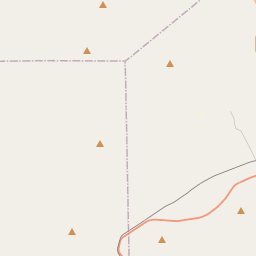First Baptist Church of Alpine
Historical marker location:






When the railroad came through this area in 1882, the settlement of Osborne was established here near natural springs. The community's name changed to Murphysville in 1883, and at that time, as the population began to grow, missionaries arrived from numerous denominations. Included among them was the noted Rev. George W. Baines. In 1883, he held what was reportedly the first Protestant meeting in the community, which became known as Alpine in 1888.
Ten years after Baines' meeting, the First Baptist Church of Alpine was officially organized on April 14, 1893. It called its first pastor, the Rev. D.B. Rose, in 1894. That same year, the church affiliated with the Sweetwater Association, and the congregation met in various locations until purchasing this site and dedicating its first sanctuary, an adobe structure, here in 1896. The congregation by that time had a Women's Missionary Union and held regular Bible and Sunday School classes. Membership increased, and next to its sanctuary in 1910, the congregation added a parsonage.
The church grew, with nearly two hundred members enrolled in Sunday School and youth and service groups. In 1915, it began work on a larger sanctuary, in use by 1917. Architect James E. Greene's design included ample sanctuary seating, as well as Sunday School rooms, a baptistery, a Ladies Aid parlor and a pastor's study.
The congregation added facilities and expanded its programs to meet the needs of the community, including the Sul Ross Teachers College, which opened in 1920. With no local public library, members established a borrowing library. Other programs included children's and youth programs, Boy Scout sponsorship, mission work in Alpine and in Mexico, and activities at Sul Ross State University. Participating in Baptist work locally and internationally, First Baptist Church continues to lead its local and regional communities through its many programs, services and dedicated members. (2003)
As one of the most visible programs of the Texas Historical Commission (THC), historical markers commemorate diverse topics in Texas history, including: the history and architecture of houses, commercial and public buildings, religious congregations, and military sites; events that changed the course of local and state history; and individuals who have made lasting contributions to the state, community organizations, and businesses.
Texas was once an independent country: After winning its independence from Mexico in 1836, Texas became its own country, known as the Republic of Texas. It existed as an independent nation for nine years before being annexed by the United States in 1845.
The modern history of Brewster County began in the mid-19th century when it was part of the larger Presidio County. It was named after Henry Percy Brewster, a secretary of war for the Republic of Texas. After the Civil War, the county experienced an influx of settlers, primarily ranchers, who took advantage of the rich grasslands and water sources in the area. Cattlemen such as Alta Adele Koch, known as the "Cattle Queen of Texas," played a significant role in shaping the county's economy.
The discovery of silver in the nearby Chinati Mountains in the late 19th century led to a mining boom in Brewster County. The town of Terlingua became a center of mining activity, attracting thousands of prospectors seeking fortune. However, the silver boom was short-lived, and by the early 20th century, the mines had closed, causing a decline in population and economic activity.
Brewster County's landscape and wildlife also played a role in its history. The establishment of Big Bend National Park in 1944 helped to conserve the region's natural beauty and attract tourists. Today, Brewster County is known for its stunning vistas, outdoor recreational opportunities, and a thriving art and cultural scene, making it a popular destination for visitors from around the world.
Brewster County Timeline
This timeline provides a condensed summary of the historical journey of Brewster County, Texas.
- 1887: Brewster County is established and named after Henry Percy Brewster, a Secretary of War for the Republic of Texas.
- 1889: Alpine, the county seat, is founded as a water stop for the Galveston, Harrisburg and San Antonio Railway.
- 1900: The completion of the Southern Pacific transcontinental railroad brings growth and prosperity to the county.
- 1921: Big Bend National Park is established, including a large portion of Brewster County.
- 1933-1938: The Civilian Conservation Corps (CCC) establishes numerous camps in the area, contributing to infrastructure development and conservation efforts.
- 1943: Construction begins on the Black Gap Wildlife Management Area, a renowned wildlife conservation and research site.
- 1998: The Terlingua ghost town is designated as a Recorded Texas Historic Landmark.
- 2007: The US-Mexico border fence is constructed through parts of Brewster County, impacting local communities.